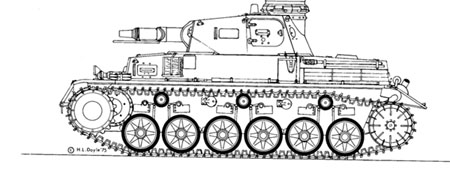
Drawing by H. L. Doyle from Panzerkampfwagen IV and Its Variants, 1975.
Panzerkampfwagen IV with Torsion Bar Suspension
Drawing by H. L. Doyle from Panzerkampfwagen IV and Its Variants, 1975.
The suspension of the early tanks developed by the German army leading up to
World War II tended to use coil-springs or leaf-springs exclusively. The Panzer III even
utilized coil- and leaf-spring suspension until the standardization of the Ausf. E. The first
German torsion bar designs appeared after E. Kniepkamp took charge of WaPruef 6 in 1936.
The torsion bar design was preferred for several reasons including its survivability and
reduced tendency for blockage by ice, snow, or mud.
Another attractive feature of the torsion bar suspension was the handling
and running characteristics. Because torsion bar suspension allowed each wheel to move
independently, the ride was drastically impoved over earlier designs. Unfortunately, at the
time of the standardization of the Panzer IV, improvement of the ride was not seen as a
priority. Therefore, Krupp ultimately decided to use the bogie pairs on leaf springs rather
than the torsion bar layout. Ultimately, the engineers at Krupp found themselves at constant
odds with the Heeres Waffenamt.
Source: Panzerkampfwagen IV and Its Variants